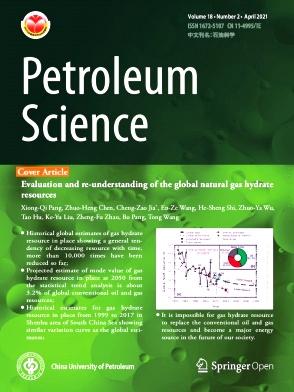渣油加氢处理过程中难熔碱性和中性氮化合物的演变
IF 6
1区 工程技术
Q2 ENERGY & FUELS
引用次数: 0
摘要
通过对加氢脱氮(HDN)比例为15.9% ~ 70.1%的原料及其加氢样品进行ESI(+)/ESI(−)FT-ICR质谱分析,全面了解了渣油加氢处理(RHT)过程中碱性和中性氮化合物的演化和分子结构。研究表明,在RHT过程中,以9-11双键当量(DBE)为特征的咔唑是难降解的中性氮化合物。它们的顽固性主要是由于它们的低芳香性和高位阻。相反,喹啉类(DBEs 7 ~ 9)是最丰富的碱性氮化合物。通过对DBE演化的细致分析,我们揭示了苯并咔唑和二苯并咔唑在渣油中复杂的反应机制,强调了喹啉作为关键中间体在消除这些化合物中的关键作用。有趣的是,低碳数或高碳数的氮化合物(对于给定的DBE)比中碳数的氮化合物表现出更高的反应活性,这可归因于较短的烷基链和更多的环芳烃结构造成的低空间位阻。经加氢处理后,大多数难降解或富集的氮化合物的分子结构主要有两种类型:具有多个环芳烃环的化合物和在氮原子附近具有长侧链的化合物。本研究揭示了氮化合物的演化机制和难降解性,以及最耐或最丰富的碱性和中性氮化合物的分子结构,为更深入地了解HDN过程,最终为合理的RHT催化剂设计和工艺开发铺平了道路。本文章由计算机程序翻译,如有差异,请以英文原文为准。
Insight into the evolution of refractory basic and neutral nitrogen compounds during residue hydrotreating process
A comprehensive insight into the evolution and molecular structure of basic and neutral nitrogen compounds during the residue hydrotreating (RHT) process was gained through ESI(+)/ESI(−) FT-ICR MS analysis of the feedstock and its hydrogenated samples, with hydrodenitrogenation (HDN) ratios of 15.9%–70.1%. This study revealed that carbazoles, characterized by a double bond equivalent (DBE) of 9–11, were the refractory neutral nitrogen compounds during the RHT process. Their recalcitrant nature was primarily due to their low aromaticity and high steric hindrance. Conversely, quinolines (DBEs 7 to 9) were the most abundant basic nitrogen compounds. Through a meticulous analysis of DBE evolution, we revealed the intricate reaction mechanisms of benzocarbazoles and dibenzocarbazoles in residual oil, highlighting the crucial role of quinolines as key intermediates in eliminating these compounds. Interestingly, nitrogen compounds with either low or high carbon numbers (for a given DBE) exhibited higher reactivity than those with medium carbon numbers, which can be attributed to the low steric hindrance resulting from short alkyl chains and more naphthenic-aromatic structures, respectively. After hydrotreatment, the molecular structures of the most refractory or abundant nitrogen compounds could consist of two main types: those with multiple naphthenic-aromatic rings and those with long side chains near the nitrogen atom. This research has revealed nitrogen compounds' evolutionary mechanisms and refractory nature, and the molecular structure of the most resistant or abundant basic and neutral nitrogen compounds, providing a deeper understanding of the HDN process and ultimately paving the way for the rational RHT catalyst design and process development.
求助全文
通过发布文献求助,成功后即可免费获取论文全文。
去求助
来源期刊

Petroleum Science
地学-地球化学与地球物理
CiteScore
7.70
自引率
16.10%
发文量
311
审稿时长
63 days
期刊介绍:
Petroleum Science is the only English journal in China on petroleum science and technology that is intended for professionals engaged in petroleum science research and technical applications all over the world, as well as the managerial personnel of oil companies. It covers petroleum geology, petroleum geophysics, petroleum engineering, petrochemistry & chemical engineering, petroleum mechanics, and economic management. It aims to introduce the latest results in oil industry research in China, promote cooperation in petroleum science research between China and the rest of the world, and build a bridge for scientific communication between China and the world.
 求助内容:
求助内容: 应助结果提醒方式:
应助结果提醒方式:


